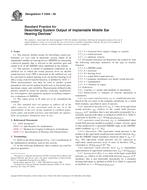We need your consent to use the individual data so that you can see information about your interests, among other things. Click "OK" to give your consent.
ASTM F2504-05
Standard Practice for Describing System Output of Implantable Middle Ear Hearing Devices
STANDARD published on 1.11.2005
The information about the standard:
Designation standards: ASTM F2504-05
Note: WITHDRAWN
Publication date standards: 1.11.2005
SKU: NS-54011
The number of pages: 6
Approximate weight : 18 g (0.04 lbs)
Country: American technical standard
Category: Technical standards ASTM
Annotation of standard text ASTM F2504-05 :
Keywords:
electromechanical hearing, hearing implant, IHD, implantable hearing aid, implantable middle ear hearing device, IMEHD, laser interferometry, middle ear, middle ear implant, system output, system performance, temporal bone, transfer function, vibrational transducer, vibratory implant, ICS Number Code 11.180.15 (Aids for deaf and hearing impaired people)
Additional information
| Significance and Use | ||||||
|
IMEHDs are alternatives to air conduction hearing aids. They are similar to air conduction hearing aids in that they process incoming sound by applying frequency shaping and compression to create an analog, vibratory audio frequency output. IMEHDs differ from hearing aids in that they do not create an airborne acoustical output signal with an electroacoustical output transducer in the external ear canal, but rather a mechanical stimulation that results in the vibration of the cochlear fluid. Therefore, the IMEHD output signal is not readily accessible after implantation in the way hearing aid output is accessible with real-ear probe microphone measurements. Different devices will use different methods of coupling to the ossicular chain or cochlea. This makes it difficult to design a uniform model of the middle ear in the way the 2-cm3 coupler is used as a model of the external ear canal with conventional hearing aids. This practice provides uniformity of data collection practices, thus allowing IMEHD in vitro performances to be evaluated and readily compared. Once clinical data are available, the performance specifications can be augmented with corresponding transfer functions or results from measurements in patients. The temporal bone is a well-accepted model that relates closely to the biomechanics of the living middle ear, which is readily relatable to hearing level. Laser Doppler vibrometry provides accurate velocity measurements in the ranges required for human hearing. |
||||||
| 1. Scope | ||||||
|
1.1 This practice defines means for describing system performance (ex vivo) and, in particular, system output of an implantable middle ear hearing device (IMEHD) by measuring a physical quantity that is relevant to the insertion gain and output level of the IMEHD when implanted in the patient. 1.2 This practice is similar to headphone calibration on an artificial ear in which the sound pressure level (in decibel sound pressure level (SPL)) measured in the artificial ear can be converted to patient hearing level (in decibel hearing level (HL)) using a known transfer function, as defined by ANSI 3.7. These measurements can then be used to predict system parameters relevant for patient benefit such as functional gain, maximum output, and variability. Measurements defined in this practice should be useful for patients, clinicians, manufacturers, investigators, and regulatory agencies in making comparative evaluations of IMEHDs. 1.3 The values given in SI units are to be considered the standard. This standard does not purport to address all of the safety concerns, if any, associated with its use. It is the responsibility of the user of this standard to establish appropriate safety and health practices and determine the applicability of regulatory limitations prior to use. |
||||||
| 2. Referenced Documents | ||||||
|
We recommend:
Updating of laws
Do you want to be sure about the validity of used regulations?
We offer you a solution so that you could use valid and updated legislative regulations.
Would you like to get more information? Look at this page.




 Cookies
Cookies
